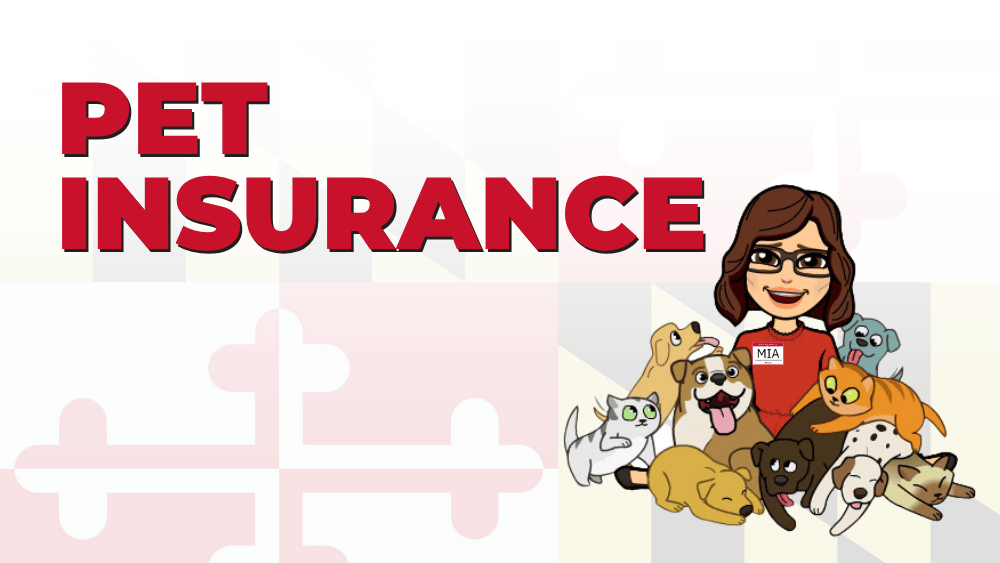
We love pets!
Pet insurance is not health insurance for your pet, although at times, it sure sounds like it is. While most of us consider our pets members of our families, legally they are personal property. That is why pet insurance is considered a type of property and casualty insurance, like automobile and homeowners policies, as opposed to a health insurance policy. Like your auto or homeowners insurance policy, most pet insurance policies have a deductible, which is an amount you must pay before the insurance company pays anything under the policy. Typically, pet insurance policies require you to pay the vet for the service and then submit the bill to the insurance company for reimbursement. Review your policy to determine if there are limitations or restrictions regarding the amount you will be reimbursed (Some pet insurance policies will require you to use a specific network of vets). For example, some policies only pay for "the reasonable cost" of medically necessary treatment, which may be less than what you paid for the treatment.
Previously, many pet insurance policies did not cover routine services, such as vaccinations or elective services, such as spaying or neutering. Because the policies insured personal property, they tended to only cover “accidental occurrences or injuries (There are three types of pet insurance coverage: accident only, accident and illness or accident, illness and wellness).” Recently, some insurers have issued policies that provide coverage for routine procedures. This is called comprehensive coverage. You will need to read the terms of the policy or speak with a company representative to determine what type of coverage the policy you select or are considering purchasing provides. The cost of the pet insurance policy will vary depending on the coverage it provides. A comprehensive policy will cost more than an accidental injury policy, as it covers more types of care your pet receives.
The policy may provide for a cap or dollar limit on the amount the insurance company will pay on a claim. This may apply to both emergency and sick visits, as well as preventive or routine care. Some policies cap the reimbursement amount for extensive surgeries or after your pet reaches a certain age. Companies often limit or even exclude coverage for pre-existing conditions (A vet may have to examine your pet to certify its health before it can be insured). Upon renewal, the company may deny further coverage for conditions previously treated under the policy. Some common coverage exclusions are dental care not associated with an accident or injury, treatment of behavioral problems and breed specific problems, such as hip dysplasia or cataracts. Cosmetic surgery like declawing and tail docking are also typically not covered. Different companies and policies have different provisions. You should be certain that you understand exactly what you are purchasing and what your policy covers and what it excludes.
The premium for coverage will vary depending on the insurer, type of pet (dog, cat, etc.), breed of pet, the level of coverage and policy deductible selected. If your pet suffers a serious injury or illness, the policy can quickly pay for itself.
You can shop for quotes and view coverage provided under the various policies by visiting each company’s website. You may contact the Maryland Insurance Administration at 410-468-2000 or 1-800-492-6116 for further information, including whether insurance companies and producers are licensed to sell policies in the state or visit our website at insurance.maryland.gov.
Helpful Tips:
- Make sure you understand any pre-existing conditions and breed specific condition exclusions that may be in your policy.
- Generally pet insurance policies do not cover preventive care, like vaccines, or wellness visits.
- If you want to insure multiple pets, you will usually need a separate policy for each.
- Know your Annual Coverage limit. Typically this ranges from $5,000 to an unlimited amount.
- Typically, you pay your veterinarian directly, and submit the bill to your insurer for reimbursement.
Watch learning the basics of Pet Insurance: Video
Frequently Asked Questions:
-
What does pet insurance cover? Benefits will vary from one policy to the next. Pet insurance may cover the cost of veterinarian treatment and medication in the event your pet becomes sick or injured. Depending on your policy, there may be limitations on payment such as deductibles or coinsurance. Coinsurance is the portion of the cost you will be responsible for paying in addition to the deductible. This is usually a percentage of the bill. Pet insurance is a type of property insurance, not health insurance for your pet.
- What does pet insurance not cover? Pet insurance does not cover pre-existing conditions. Generally, most policies do not cover routine care and wellness visits for services such as microchipping, vaccinations, teeth cleanings, etc. unless you purchase additional coverage.
-
Is pet insurance expensive? There are several factors that will impact the cost including age, breed and what the policy covers. The price could start low and increase as your pet ages and is more likely to become ill.
-
Is pet insurance subject to a deductible? Yes, your policy will probably have a deductible. The deductible may apply for a specific illness or injury with only one deductible for initial and follow up treatments while other policies apply a deductible for every visit, even for the same condition. Please check your policy or contact the insurance company to learn how your coverage works.
__________________
To learn more about our consumer education and advocacy initiatives, read our Consumer Publications. These materials provide information about most types of insurance from auto, homeowners, health and life policies to annuities, title insurance and coverage for boats.
If your community group, HOA or organization is interested in a virtual or in-person presentation or speaker, contact Associate Commissioner Patricia Dorn at patricia.[email protected] or click here.